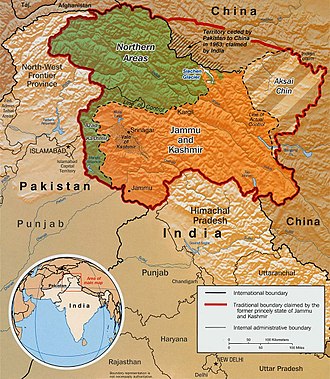| Saltoro Mountains | |
|---|---|
| Saltoro Muztagh | |
 | |
| Highest point | |
| Peak | Saltoro Kangri |
| Elevation | 7,742 m (25,400 ft) |
| Coordinates | 35°24′01″N76°50′55″E / 35.40028°N 76.84861°E |
| Geography | |
 | |
| Location | Actual Ground Position Line, on the border between Indian and Pakistani controlled territories |
| Borders on | Masherbrum Mountains |
The Saltoro Mountains form a subrange within the Karakoram Range [1] and are situated in the southeastern part of the Karakoram. They lie on the southwest side of the Siachen Glacier, which is one of the two longest glaciers in the world outside the polar regions.[ citation needed ] The name "Saltoro" is also associated with the Saltoro Valley, located west of this range and descending on the Pakistani side of the Saltoro Range, which generally follows the Actual Ground Position Line (AGPL).
Contents
The Saltoro Range, of which western slopes are held by Pakistan and higher peaks and passes are held by India all of which remain snowbound throughout the year, provides access to Siachen Glacier to its east through five passes, i.e., listed from south to north are Chulung La (5,800m), Yarma La (6,100m), Gyong La (5,640m), Bilafond La (6,160m) - also called Saltoro La, and Sia La (7,300m). [2] Saltoro Kangri peak, Saltoro River, and Saltoro Valley are features within the Saltoro Mountains range. The Actual Ground Position Line (AGPL) demarcates the boundary between the areas held by India and Pakistan in this region. In the Siachen area, India controls the high peaks and passes, while Pakistan occupies the lower peaks and valleys to the west. [3]
The Saltoro Mountains are part of the Lesser Karakorams and are situated on the southwestern side of the major Karakoram glaciers, including the Siachen, Baltoro, Biafo and Hispar Glacier, which run from east to west. The primary ridge of the Karakoram Range is located to the northeast of these glaciers.
The subranges of the main ridge are generally referred to as "Muztagh," while the mountain groups within the Lesser Karakorams are often designated as individual mountains, ranges or groups. [4]
The Saltoro Range is claimed by India as part of the Ladakh region and as part of the Gilgit–Baltistan region by Pakistan. Between 1984 and 1987, India assumed military control of the main peaks and passes of the range, with Pakistani forces holding the glacial valleys just to the west.[ citation needed ] Hence, despite high peaks and dramatic climbing opportunities, they are rarely visited except by military forces due to the ongoing Siachen Conflict.
On the southwest side, the Saltoro Mountains drop steeply to the valleys of the Kondus and Dansam Rivers, which join to form the Saltoro River, a tributary of the Shyok River. This in turn flows into the Indus River. To the northwest, the Kondus Glacier separates the range from the neighboring Masherbrum Mountains, while on the southeast, the Gyong River, Glacier, and Pass (Gyong La) separate the northern Saltoro Mountains from the southern Saltoro Mountains or "Kailas Mountains" (not to be confused with Tibet's sacred Mount Kailash).





